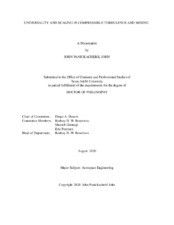| dc.description.abstract | Compressible turbulence and turbulent mixing play a critical role in diverse systems ranging
from engineering devices to astrophysics. Examples include high-speed scram jets, hypersonic
flows, combustion and star formation. The phenomenon is poorly understood due to complicated
interactions between the compressible (dilatational) and vortical (solenoidal) modes in addition
to the coupling of the flow field with thermodynamic variables. Attempts to make progress using
traditional governing parameters, namely the Taylor Reynolds number, (Rλ) and the turbulent
Mach number, (Mt) have been marred with inconsistencies and conflicting results in the literature. Resolving these discrepancies, further our understanding of this phenomena, develop new turbulence models for actual applications and affect flow control in practical situations are the ultimate objectives of this project. For this, we perform direct numerical simulations for a wide range of forcing conditions using state-of-the-art massively parallel codes that we show to be scalable up to 431200 cores at world-record resolutions. The aggregate database comprises an unprecedented wide range of values of the governing parameters. Through a novel asymptotic theoretical approach and systematic data analysis, we identify a new non-dimensional scaling parameter, δ, the ratio of compressible to vortical strength along with traditional parameters to unravel universal behaviour and scaling laws resolving several major issues currently plaguing the field. This could prove a paradigm shift in how compressible turbulence is studied. We predict the energy distribution across scales of the dilatational part of turbulent kinetic energy by dividing the δ − Mt plane into different physical regimes. These insights are also applied to passive scalar mixing. Although the large-scale of motion of passive scalars is oblivious to the effects of compressibility, it has a strong effect on the smallest scales. With these insights, we successfully parametrize the mixing efficiency in terms of the governing parameters. Our results have major implications in turbulence modeling paving the road towards more accurate, robust and generic models. In order to generate the current unique database, several computational issues had to be addressed, such as IO at scales, the use of accelerators, and the overhead associated with high levels of parallelism. Thus we also contribute towards extending the capabilities of the grand computational challenge of simulating turbulence at realistic conditions seen in nature and engineering applications. | en |


